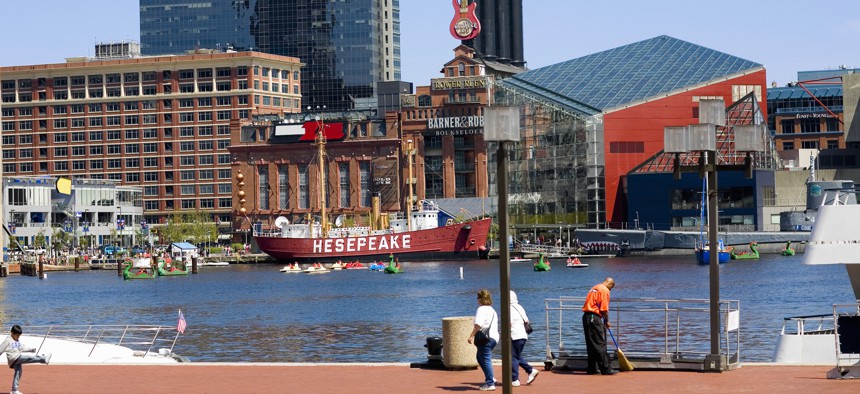Urban climate lab makes holistic appraisal of resilience

Glowimages/Getty Images
The Baltimore Social-Environmental Collaborative will integrate environmental, health and community response data to drive potential climate solutions that support equity and resilience.
To better understand the effects of climate on Baltimore residents, a multidisciplinary research effort called the Baltimore Social-Environmental Collaborative (BSEC) is monitoring environmental and health data and soliciting resident feedback.
The collected data will support a study of the interdependent environmental, ecological, infrastructure and human components of urban systems and guide climate solutions and community-scale resilience. Data on air quality, emissions and weather impacts on Baltimore will help policymakers prepare equitable solutions based on data-driven models.
Baltimore’s infrastructure, population, potential for increased heat and floods and air and water pollution make it an ideal laboratory for climate solutions. It is also representative of many industrial cities across the country.
“Part of what we want to do is be able to predict climate change conditions and air quality conditions at the neighborhood scale,” said Kenneth Davis, atmospheric and climate professor and principal investigator of the team from Penn State, one of the participating universities. “In order to test if our models do the right thing, we need measurements at the neighborhood scale that we can compare to.”
To tackle this task, researchers are deploying monitoring tools around the city, including Doppler lidar in the downtown area, which measures different characteristics of the wind and the depth of the boundary layer, the part of the atmosphere where people live and that directly feels the effect of the earth's surface, Davis said. A ground-based remote sensing unit near the coast will measure atmospheric winds for monitoring bay breeze impacts on the city. “These distributed networks will help to evaluate the outcomes of our models,” Davis said.
There will be four towers equipped with sensors that monitor Baltimore’s land-atmosphere exchange to measure how much the wind is slowed down by the urban surface. The air- and temperature-quality sensors will be spread across urban residential areas to evaluate the environment where people interact, Davis said. Data from the sensors will also provide insight to how much the land surface heats, moistens or cools the atmosphere.
Data storage will vary between research teams and instruments, but Davis anticipates information from the lidar and air- and temperature-quality sensors to be sent over the internet to researchers at Penn State.
Another aspect of the project involves collecting community input, according to Michael Bader, faculty director of Hopkins’ 21st Century Cities Initiative, the program supporting the Baltimore lab. Bader’s team aims to conduct annual community surveys to measure social inequalities in potential climate policies “to develop from the very beginning an equitable action plan that can help to mitigate or adapt to climate change in a way that prioritizes environmental justice,” he said.
To conduct surveys, a representative sample of city residents will receive letters encouraging them to take an online survey, Bader said. The survey aims to answer questions on the tradeoffs that different policies have on populations, how people perceive those policies or if they feel their needs are incorporated into those policies, he said.
Researchers hope to receive 1,000 to 1,100 responses for each survey, which will be statistically analyzed to assess variances in attitudes toward climate policies among individuals across demographics such as level of education or race. “What we’ll be able to do and hopefully be able to measure from that are ways that different solutions are more or less equitable, according to people in Baltimore City and Baltimore County,” Bader said.
Data from electronic medical records that have been stripped of personally identifiable information will also be used to measure health outcomes of potential solutions, principal investigator and Johns Hopkins earth and planetary sciences professor Benjamin Zaitchik said. Researchers send their environmental data to the precision medicine analytics platform at the Johns Hopkins Medical School, where the data is integrated “behind multiple screens of privacy protection.”
The data will help researchers answer questions like: “If I have an intervention by doing this kind of urban greening strategy, I reduced air temperatures a little bit more by reducing emissions of pollutants from vehicles from traffic … what’s the outcome in terms of health?” Zaitchik said.
Results will be presented to stakeholders as interactive graphics, GIS maps and other visualizations, Zaitchik said.
Other participants of the BSEC include:
- Cary Institute for Ecosystem Studies
- City University of New York
- Drexel University
- Morgan State University
- National Renewal Energy Laboratory
- Oak Ridge National Laboratory
- United States Forest Service
- University of Maryland, Baltimore County (UMBC)
- University of Virginia
BSEC is part of the Department of Energy’s Urban Integrated Field Laboratories program, which aims to study the interaction between climate and urban landscapes through field observations, data assimilation and modeling. With labs in four U.S. cities, the knowledge gained from the UIFLs will help authorities better grasp the social and environmental needs of their communities.
Chicago, Port Arthur-Beaumont, Texas, and a megaregion in southwest Arizona—including Tucson, Phoenix and Flagstaff—will also host integrated labs supported by a $56 million grant from the Department of Energy as part of President Joe Biden’s goal of a net-zero carbon economy by 2050.
NEXT STORY: How data sharing revs up mobility decisions






